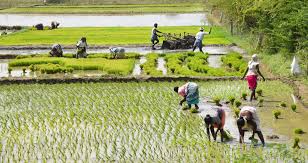Paddy under DSR system far from target this time too.
By Gurpreet Singh Nibber
It seems not many farmers in Punjab are interested to cultivate paddy using the direct seeded rice (DSR) method despite the fact the state department of agriculture has been promoting it to conserve water.
The DSR method entails sowing paddy seeds directly into the ploughed field with adequate moisture and simultaneously dropping fertiliser and weedicide into the seed holes. The seeds sown are not irrigated for 21 days till germination takes place. Under this technique, sowing starts 15-21 days early to cover the germination time.
Nearly 95% (over 28 lakh hectares or 68.5 lakh acres) of the paddy transplantation work is over, but only 2.25 lakh acres have been sown under the DSR method whereas the target for this season was 7 lakh acres. According to agriculture officials, the area under the DSR might not register a considerable increase.
As of now, Abohar and Fazilka belts in southwest Punjab have adopted the DSR method whereas the rest of the state predominantly prefers the traditional method of transplanting saplings into puddled fields. In the last kharif season, the DSR method was applied on 1.75 lakh acres against the target of 5 lakh acres. Farmers prefer the method of transplanting paddy saplings in puddled fields with water level up to nine inches.
Punjab Agricultural University vice-chancellor SS Gosal said, “As long as labour for transplanting paddy saplings is available easily, much success cannot be expected for the DSR method. We want farmers to adopt it in the long run.” Adopting the DSR system helps farmers save ₹3,500-4,000 that labourers charge for transplanting saplings, he said.
Another reason, according to Gosal, behind not many farmers taking it up is easy availability of subsoil and canal water. The DSR system helps in saving 15% water during the crop life.
What troubles paddy growers taking up the DSR is the weed coming up along with the crop, which is negligible when paddy is transplanted in puddles. According to experts, there is a method of using weedicide. In case it is used amid lack of moisture, the crop is damaged.
According to Ravisher Singh of Mucchal village in Amritsar district, and other farmers, the biggest problem with the DSR method is a variety of weed coming with the crop, non-availability of best suited weedicides and its cost that crosses the cost of labour for sowing paddy by transplantation method. “Ultimately, farmers have to shift to this method to conserve water. Many farmers have ploughed their fields after facing problems at the initial stage of the crop,” he said.
A variety of weeds come with the DSR method for which sprays are to be used, he said, adding that any new scheme, process or a system takes time to become popular, particularly when a system is in practice and giving successful results.
This article has been republished from The Hindustan Times.

